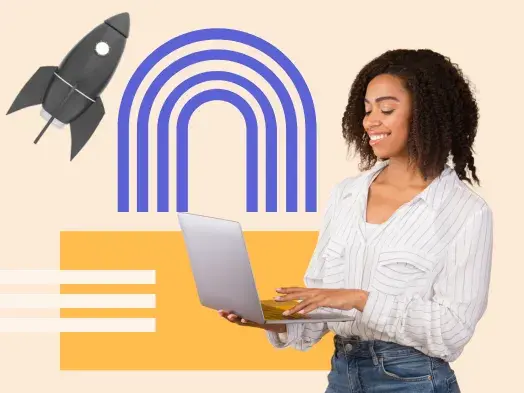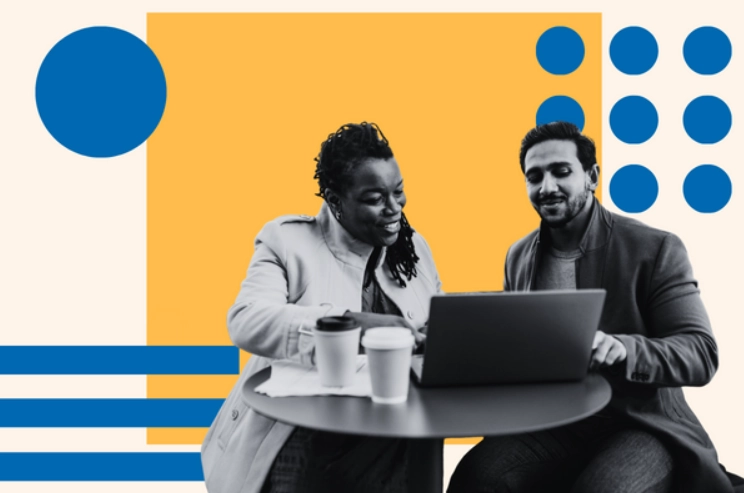This industry was valued at $166 billion market worldwide in 2021. With that growth comes higher competition and higher customer expectations. As a subscription model, SaaS brands need to earn their customers' loyalty month after month and year after year.
As brands look to streamline their SaaS subscriptions and cut the ones that aren't driving value, a customer success strategy can make sure that yours isn't next on the chopping block.
In this guide, we'll cover:
- What is customer success in SaaS?
- Why Customer Success Matters
- Metrics That Your Customer Success Team Should Track
- The Roles You Need on Your Customer Success Team
- Tools for Customer Success in SaaS
What is customer success in SaaS?
Customer success in SaaS is the discipline of setting customers up to reach their goals through intentional onboarding, training, relationship-building, and support. Unlike customer support which reacts to support requests, customer success proactively creates plans and workflows to help customers get the most out of their product.
Some startups handle customer success through account management or customer support. However, more and more SaaS brands are treating customer success as its own unit and revenue center.
Gainsight's 2022 Customer Success Index reported that 95% of B2B companies have a customer success function. Further, the average SaaS company spends 6% of its revenue on customer success and customer success operations.
Why Customer Success Matters in SaaS
Every SaaS brand needs to balance both sides of the equation to delight customers: functional software with exceptional service.
The typical medium-sized company spends $2.47 million per year, or $8,580 per employee on SaaS, according to Vendr. Despite this large investment, many companies struggle to implement and measure the ROI of the tools they have purchased.
When users never fully adopt a product, are frustrated by UX issues, or can't measure the outcomes, they're likely to cancel. That leads to customer churn and lost revenue for SaaS companies who then have to invest money in customer acquisition to replace that revenue.
Customer success helps companies reduce churn and boost customer satisfaction and retention and revenue.
6 Components of Customer Success in SaaS
To build a customer success program in your SaaS business, integrate these six core components.
1. Onboarding
Onboarding is typically where clients first interact with customer success after a sales handoff. During onboarding, customer success teams set up user accounts, assist with data migration, and often complete one-on-one training and user support.
Successful onboarding is critical for product adoption and customer happiness.
2. Success Planning
You can't show your customers how you're meeting their goals if you don't know what they are. A success plan defines your customer's objectives and lays out how you plan to meet them.
To create a success plan, ask your customers what their expectations and pain points are. Next, outline a customized activation plan with key activities, people involved, and KPIs for progress.
3. Quarterly Business Reviews
Customer success teams shouldn't go silent after a customer is onboarded.
To make sure the customer success plan is on track, SaaS customer success managers should check in regularly with their customers. During these calls, CS managers should discuss product usage, satisfaction, and any big-picture challenges they're facing.
4. Playbooks
Every customer success team should have a playbook outlining best practices for customer success at the company. Playbooks can include procedures, benchmarks, and even scripts for teams to follow.
5. Self-service Content
While customer success is built on personal relationships, self-service content is an important supplement to one-on-one support.
Examples of self-service customer content include technical knowledge bases, training modules to help customers learn how to use the products, and online peer communities.
Remember: How self-service content is pushed out to customers (email drip campaigns, learning paths, chatbots) can be as important as the content itself. Build a plan to familiarize your team with these resources.
6. Feedback Loops
Customer success can play a key role in flagging recurring product issues for product teams. Creating these feedback loops is a win-win: Brands improve their software, and customers feel a higher level of trust when changes are implemented.
Metrics That Your Customer Success Team Should Track
Your customer support team may already track individual engagement metrics, such as average ticket time and first contact resolution. However, customer success should track holistic metrics that show customer satisfaction and how it impacts revenue.
Make sure your customer success team is tracking these top customer success metrics.
Customer Retention Rate
Customer retention rate is a percentage that shows how many of your customers you retain over a defined period of time (such as a quarter or year).
A lower percentage can indicate challenges with your product, service, or business model.
You can calculate your customer retention rate by subtracting the number of customers at the end of a timeframe from the customers acquired during a time frame. Then, divide the remaining value by the number of customers at the start of the period. Multiply by 100 for the percentage.
Customer Churn
Customer churn rate is the opposite of a customer retention rate and shows what percentage of your customers you're losing in a given timeframe.
Calculate your customer retention rate with the formula below.
%20%20costumes%20at%20start%20of%20period%20x%20100..webp?width=650&height=325&name=customer%20success%20in%20SaaS%20metric%2c%20CRR.%20(customers%20at%20end%20of%20period%20-%20customers%20acquired%20during%20period)%20%20costumes%20at%20start%20of%20period%20x%20100..webp)
Customer Satisfaction Score (CSAT)
Many companies use a quick survey asking customers to rate their satisfaction with a feature, purchase, or interaction on a simple number scale (often 1-5 or 1-10). This is popular and effective because it's quick for users and easy to administer.
You can calculate your customer satisfaction score (CSAT) from survey results with the formula below.
![customer success in saas metrics, CSAT, (# Positive Responses # Total Responses] x 100.](https://53.fs1.hubspotusercontent-na1.net/hub/53/hubfs/customer%20success%20in%20saas%20metrics%2c%20CSAT%2c%20(%23%20Positive%20Responses%20%20%23%20Total%20Responses%5D%20x%20100..webp?width=650&height=325&name=customer%20success%20in%20saas%20metrics%2c%20CSAT%2c%20(%23%20Positive%20Responses%20%20%23%20Total%20Responses%5D%20x%20100..webp)
For example, 75 positive responses out of 125 total survey responses would give you a CSAT of 60%. Studies have found gaps in the customer satisfaction expressed by executive buyers and end users, so make sure you survey a mix of people.
Product Adoption
Monitoring how often your product is used can help predict churn.
There are multiple ways to measure product adoption. You can measure product utilization through monthly and daily active users or can measure what percentage of your users reach key milestones in using your software, such as sending an email campaign.
Customer Lifetime Value (CLV)
Customer lifetime value is an estimate of the total revenue a company will earn from a customer over its account lifecycle.
For example, a $50,000 annual contract over 10 years equals a $500,000 CLV. This metric helps companies estimate the ROI of customer acquisition and customer success initiatives.
Net Revenue Retention (NRR)
Net revenue retention goes beyond the number of customers retained to look at the percentage of revenue retained from one period to the next. NRR factors in cancellations, upgrades, and downgrades to give a more nuanced picture of recurring revenue growth through retention, cross-sells, and upsells.
The Roles You Need on Your Customer Success Team
As more SaaS brands build out customer success units, they need to build out a team that can put systems, relationships, and resources in place to drive customer delight and retention.
Regardless of their role, customer success professionals should be empathetic problem-solvers who can speak to both technical solutions and business goals. Customer success teams also need solid communication skills to help customers and collaborate internally.
Implementation Specialist
Implementation specialists, also known as onboarding specialists, guide new customers through the steps to set up their accounts, migrate their data, and learn how to use the SaaS platform.
Part coach, part project manager, and part data technician, implementation specialists need communication skills and technical knowledge to be successful. This entry-level role is a great starting point for anyone interested in breaking into customer success.
Customer Success Manager (CSM)
SaaS customer success managers take ownership of a portfolio of clients and are responsible for their success and retention. CSMs interface with customers to define goal outcomes, create success plans, and coach and train users on the software. CSMs often manage a team of implementation specialists or junior CSMs. Depending on the company structure, they may be responsible for upsells and renewals.
Customer Success Operations Manager
Customer success operations, or CS Ops for short, is a fast-growing discipline within customer success. Unlike customer-facing CSMs, customer success operations managers manage the internal workflows and processes that make customer success units successful.
Customer success operations managers monitor customer usage, forecast revenue, implement workflows and tools, and manage data and KPIs.
VP of Customer Success
A VP of Customer Success leads customer success and customer success operations for a SaaS brand. VPs are responsible for setting the vision for customer success at a company, hiring a team, and stepping in to coach CSMs on key accounts.
Chief Customer Officer
A chief customer officer, or CCO, leads all customer functions for a company including customer support and customer success. CCOs hold a seat at the leadership table and advocate for customer success priorities amidst discussions with product, engineering, and sales.
Tools for Customer Success in SaaS
To drive results at scale, customer success teams need tools that let them track, manage, and communicate with customers. Here are some tools every team should have in their customer success tech stack.
Customer Relationship Management (CRM) Software
The most important software for a customer success team is a comprehensive CRM solution. A CRM allows SaaS brands to integrate sales, customer success, and customer support all in one place.
Unlike standalone email or ticketing tools, a CRM allows customer success teams to see a full history of each customer's communications, interactions, and support tickets — and respond within the system. This helps CSMs to understand the full context of a customer's experience when supporting them.

Examples of CRM software:
- HubSpot
- Salesforce
- Zoho CRM
- Freshsales
- Pipedrive
Support Ticketing Software
To resolve customer requests in a timely fashion, SaaS brands need ticketing software to track, assign, and manage support requests. While customer support may manage the day-to-day technical support requests, it's important for CSMs to see the help tickets their customers log to help them mitigate frustrations.

Examples of support ticketing software:
- HubSpot Help Desk
- Zendesk
- Sprinklr
- Help Scout
Chat Software
Genesys reports that customer interactions on chatbots, social media, and mobile apps more than doubled between 2017 and 2021. Customers have higher expectations but also are engaging with companies more – creating opportunities for brands to win their loyalty.
Customers want to receive support through channels convenient to them. Often, that's through chat, WhatsApp, Facebook Messenger, or even text instead of waiting on hold for a customer support call.
Chat software for customer support integrates multiple chat channels into a single, unified inbox for easy communications management.

Examples of chat software:
- HubSpot Service Hub
- LiveChat
- Zoho Desk
- Zendesk Support
Learning Management Software (LMS)
Many SaaS brands offer their customers training pathways to help their customers learn and adopt their software. A good LMS can set custom pathways for customers, gamify learning, and boost customer satisfaction.

Examples of LMS software:
- TalentLMS
- SAP Litmos
- UserGuiding
- Lessonly by Seismic
Boost Customer Satisfaction and Retention with Customer Success
The SaaS landscape is becoming more and more competitive with growing customer acquisition costs. SaaS brands can retain and upsell their existing customers by investing in customer success.
The ROI of customer success is clear. Gainsight found that companies who invest 10% of revenue in their customer success and CS Ops teams (67% more than the median spend) report the highest NRR.
The math backs up common wisdom – the more support you have as you use a product, the happier you'll be.
Customer Success
.png?width=112&height=112&name=Image%20Hackathon%20%E2%80%93%20Vertical%20(85).png)

.png)




![How To Write a CSM Resume [+ Free Templates]](https://53.fs1.hubspotusercontent-na1.net/hubfs/53/customer-success-manager-resume-1-20241031-2293336.webp)







